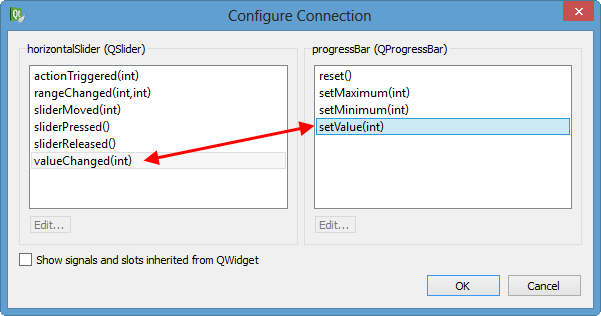Qt5 Signal Slot Example
Connect QML signal to C11 lambda slot(Qt 5) (2) Instead of creating lambda functions on the fly to deal with different signals, you may want to consider using a QSignalMapper to intercept the signals and send them to a statically-defined slot with an argument dependent on the source.
- For our signal and slot example, we will handle two types of widgets such as LineEdit and Label. Under the input widgets, choose “QLineEdit” and drag and drop to the Dialog form. In the same way, click a Qlabel from the Display widgets drag and drop to the Dialog form.
- This is simply a function that gets called when the signal occurs. In the above example, our slot shows a message box. The term slot is important when using Qt from C, because slots must be declared in a special way in C. In Python however, any function can be a slot – we saw this above.
- Connect(controls, SIGNAL(changeVolume(int)), player, SLOT(setVolume(int))); The example also allows us to change various video properties by means of the QVideoWidget object. We can go to Full Screen mode with a single button click, and back again.
Introduction
Remarks
Official documentation on this topic can be found here.
A Small Example
Signals and slots are used for communication between objects. The signals and slots mechanism is a central feature of Qt and probably the part that differs most from the features provided by other frameworks.
The minimal example requires a class with one signal, one slot and one connection:
counter.h
The main sets a new value. We can check how the slot is called, printing the value.
Finally, our project file:

Connecting overloaded signals/slots
While being better in many regards, the new connection syntax in Qt5 has one big weakness: Connecting overloaded signals and slots. In order to let the compiler resolve the overloads we need to use static_casts to member function pointers, or (starting in Qt 5.7) qOverload and friends:
Multi window signal slot connection
A simple multiwindow example using signals and slots.
There is a MainWindow class that controls the Main Window view. A second window controlled by Website class.
The two classes are connected so that when you click a button on the Website window something happens in the MainWindow (a text label is changed).
I made a simple example that is also on GitHub:
mainwindow.h
Qt Signal Slot Example C
mainwindow.cpp
website.h
website.cpp
Project composition:
Consider the Uis to be composed:

- Main Window: a label called 'text' and a button called 'openButton'
- Website Window: a button called 'changeButton'
Qt Signal Slot Example
So the keypoints are the connections between signals and slots and the management of windows pointers or references.
The new Qt5 connection syntax
The conventional connect syntax that uses SIGNAL and SLOT macros works entirely at runtime, which has two drawbacks: it has some runtime overhead (resulting also in binary size overhead), and there's no compile-time correctness checking. The new syntax addresses both issues. Before checking the syntax in an example, we'd better know what happens in particular.
Let's say we are building a house and we want to connect the cables. This is exactly what connect function does. Signals and slots are the ones needing this connection. The point is if you do one connection, you need to be careful about the further overlaping connections. Whenever you connect a signal to a slot, you are trying to tell the compiler that whenever the signal was emitted, simply invoke the slot function. This is what exactly happens.
Here's a sample main.cpp:
Hint: the old syntax (SIGNAL/SLOT macros) requires that the Qt metacompiler (MOC) is run for any class that has either slots or signals. From the coding standpoint that means that such classes need to have the Q_OBJECT macro (which indicates the necessity to run MOC on this class).
The new syntax, on the other hand, still requires MOC for signals to work, but not for slots. If a class only has slots and no signals, it need not have the Q_OBJECT macro and hence may not invoke the MOC, which not only reduces the final binary size but also reduces compilation time (no MOC call and no subsequent compiler call for the generated *_moc.cpp file).